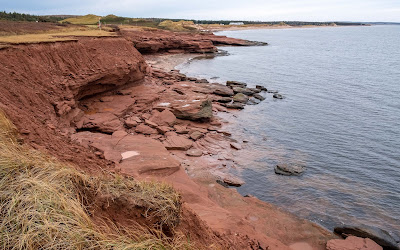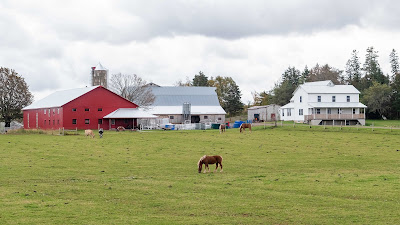This post covers the three other provinces we visited in eastern Canada, namely Prince Edward Island, New Brunswick and Nova Scotia and simply as a reminder, these provinces can be seen on the map below.
After disembarking the ferry at 6pm in Nth Sydney, Nova Scotia and having spent the night at another Walmart carpark, we then took back roads heading west through New Glasgow and stayed overnight in a campground at Pictou, more on this later.
The following morning, it wasn’t very long before we finally reached ‘the bridge’ otherwise known as the Confederation Bridge, all 12.9 kms of it, one lane in either direction, taking us from the mainland to Prince Edward Island, another province of Canada.
 |
| Camping at Pictou and in sunshine for a change |
 |
| Crossing the loooong Confederation Bridge to Prince Edward Island |
Prince Edward Island (PEI)
We were on PEI for only 3 nights and our actual routes throughout the island can be seen below.
 |
| Route around PEI including bridge crossing |
 |
| Few examples of farms on PEI |
 |
| On PEI they bale their hay in rolls, put all the rolls in long lines and then cover all of the rolls together to protect them from the weather |
 |
| Potato carting truck on PEI |
 |
| Fishermen at work together on PEI |
 |
| Oyster 'tong' example - thanks to Google |
You can have as much of these as you want before the lobster arrives with an apron to wear, instructions on how to extract the meat and some tools. After all this there was a choice of deserts also.
 |
| First we we provided the 'how to' of eating lobster |
 |
| Getting ready to tuck into some fresh lobster |
 |
| THE green gables home of 'Anne of Green Gables' book fame |
 |
| Lucy Maud Montgomory's actual birth home |
 |
| One of the many lighthouses on PEI |
 |
| Part of PEI's coastline and its red cliffs |
Something else PEI has plenty of churches of multiple denominations, again located across the island near those small communities.
A Frenchman named Jacques Cartier, first founded PEI in 1534 and it was claimed by France who largely ignored it for 2 centuries and viewed it as excellent for farming. They named the island St Jean, but the British who took it from France then traded it back to France for a city in India.
Later, the British captured it again and deported 5,000 French and Arcadian settlers, the Arcadian being pastoralists wanting to live close to nature. Many Arcadians moved to Louisiana and became known eventually as Cajun, a play on their original Arcadian name.
So PEI had a bit of a strange start and became PEI in 1799 and evolved from then to the present, but after 2 days and looking at many farms and admiring some of the autumn colours beginning to erupt, we returned to ‘the bridge’ and crossed back to the mainland into New Brunswick.
 |
| Nice to see the start of autumn colours appearing whilst on PEI |
New Brunswick
In visiting this province we were again challenged with winterizing when it came to trying to find places to camp, so we had to make numerous phone calls to see which locations were still open.
It was also time to be re-acquainted with Canada’s interesting mixed language reality with frequent people answering our calls in French. Thankfully all of them spoke enough or plenty of English.
Our route through New Brunswick can be seen below and this province is home to ~800,000 people and is about 3% larger in physical size than Ireland but 83% of it is covered in trees and those trees were one of the reasons we were visiting. It was Autumn and the trees had already begun changing colour.
 |
| We managed to cover a fair bit of New Brunswick |
New Brunswick’s main economic earners are agriculture, aquaculture and timber products. McCain Foods headquarters is also located in New Brunswick which pays testament to the provinces’ credentials in food production.
Back to this word Arcadian which in this part of the world refers to the original French settlers who worked the land in the provinces we were visiting.
As a result of a 6 colonial wars during the 17th & 18th centuries in what was known then as Arcadia, the British expelled thousands of people as a part of Britain wanting to ensure it had control and remove France’s influence. People of Arcadian descent register this by placing a star on their homes throughout New Brunswick.
Now if you boil it right down to the primary things we saw in New Brunswick it really comes down to 3-4 things. Tides and their effects, covered bridges, some nice little towns and autumn colours because of all the trees everywhere.
So lets start with the autumn colours which will involve maybe a few photos, they were just stunning and caused us to do many u-turns to go back and capture specific scenes.
As we drove the various scenic routes and headed further north then west within the province, the colours changed markedly from lots of very vivid reds, yellow, orange and burgundy colours near the coast in the south, predominately bright yellow and orange through the middle and finally, more dullish browns and yellows in the north west.
So here are a few photos of the range of autumn colours we experienced and at times it really did take our breath away. There are more photos in the link at the end of this post.
 |
| Few examples of a LOT of autumn colour opportunities |
 |
| The longest covered bridge in the world |
A few of the covered bridges happened also to be located in one of the few picturesque little towns we found, each town having its own unique character and buildings from bygone eras.
 |
| Some lovely older style homes in New Brunswick |
 |
| St Martins was a very pretty little town with a lot to offer |
 |
| It also had sea caves and a great place to stop for lunch |
As a bonus, we did manage to see the world’s largest axe in Nackawic, New Brunswick, standing 15 metres tall, weighing 55 tonnes with an axe head 7 metres wide made out stainless steel.
 |
| Yep... the world's largest axe |
 |
| Looking down along the Bay of Fundy's coastline |
 |
| Cape Enrage's lighthouse and the coast it watches over |
We stayed 2 nights in a near deserted campground near Hopewell Rocks, a National Park, which happened to have closed down for the season on the afternoon we arrived.
It’s here you get to see the full effect of the Fundy Bay tides by visiting some rock formations called The Flowerpots and the reason for staying 2 nights was to ensure we wouldn’t be messed up by tide times.
So we visited the same locations a few times to catch photos at low tide and then again at high tide as shown below. We also walked down onto the ocean floor amongst The Flowerpots to appreciate just how big the rock formations are and to put the tide movements into context.
 |
| Tide out at the Flowerpots... |
 |
| ...and the tide back in again |
 |
| Down amongst the Flowerpots... look carefully for Rob in arch of the photo above |
A small flock of Canadian Geese landing on the river in front of us, then casually started washing themselves.
Earlier than predicted and downstream from us we could see something happening in the water and it was heading towards us, a small looking wave moving upstream and at a fairly quick pace, splashing lots of water up the sides of the banks.
 |
| Here comes the tidal wave |
 |
| Certainly disturbed the peace of the geese |
 |
| And there goes the Moncton Bore heading upstream |
Nova Scotia
The reason for only a brief description of this province is because we had been here before in 2001 so had not planned to do things like drive out to Cape Breton again, certainly a very picturesque place to visit.
When we landed into Halifax, the capital of Nova Scotia for our 3 nights stay before heading to Newfoundland, we enjoyed clear skies and warm weather which made walking around the town very enjoyable, especially down along and through the port area.
 |
| Few scenes from around Halifax, Nova Scotia |
They have quite a few boutique and casual cafes scattered around in and near the city and was a very relaxing way to enjoy some pleasant home cooked style food.
Whilst travelling from North Sydney to ‘the bridge’ on the way to PEI, we also stayed in a little town on the coast called Pictou which means ‘New Scotland’ in Latin. Both the small township was a delight to be in as was the campground run by a person who really cared about service.
 |
| In and around Pictou, Nova Scotia |
We know we won’t return here but we certainly learned there are a bunch of very resilient, friendly and good humoured people who call this part of the world home and were thankful they taught us a lot about living in eastern Canada.
Till the next post… go well!





























No comments:
Post a Comment